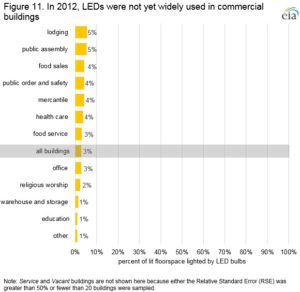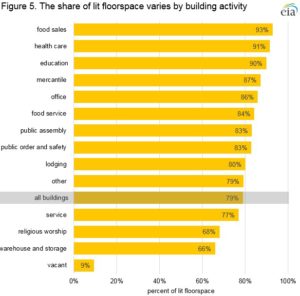Large commercial buildings more likely to use lighting control strategies
The most recent Commercial Buildings Energy Consumption Survey collected new information about lighting control technologies and strategies in the United States in 2012. Compared with other investments in energy efficiency—such as upgrading heating, ventilation, and air-conditioning systems or replacing insulation—lighting controls are often relatively easy, accessible and affordable changes. A new EIA report, Trends in Lighting in Commercial Buildings, details these strategies and provides information about lighting technologies in commercial buildings, including healthcare facilities.
 Lighting control technologies provide the appropriate level and type of lighting to a building and save on electricity costs. The use of these systems is more common in large, lit commercial buildings with at least 50,000 square feet of floorspace.
Lighting control technologies provide the appropriate level and type of lighting to a building and save on electricity costs. The use of these systems is more common in large, lit commercial buildings with at least 50,000 square feet of floorspace.
One of the most common strategies involves only using lights when people are in a room or space. Occupancy sensors reduce lighting when rooms are unoccupied by automatically turning off or dimming lights. Occupancy sensors were used in only 16 percent of all lit buildings in 2015 but in 55 percent of large lit buildings. A more comprehensive approach called plug-load control automatically turns off lights and wall plugs when people leave a room or space. Plug-load controls were reported in 1% percentof all lit buildings in 2015 but in 3 percent of large lit buildings.
A second set of strategies controls building lighting based on the time of day. Scheduling automatically dims or turns off lights at certain times of the day. Scheduling was used in only 18 percent of all lit buildings in 2015 but in 43 percent of large lit buildings. Building automation systems control the mechanical, electrical and plumbing systems in buildings, but can also control the lighting. These systems often rely on occupancy schedules rather than sensors and were reported in 4 percent of all lit buildings and 19 percent of large lit buildings in 2015. Demand-responsive lighting reduces lighting by dimming or turning off lights at times of peak electricity pricing. This strategy was used in 4 percent of all lit buildings and 6 percent of large lit buildings.
A third set of strategies saves energy by adjusting the amount of light produced by bulbs to give just enough light to a space for the conditions or the tasks performed there. Multi-level lighting or dimming adjusts lighting power through continuous dimming, stepped dimming or stepped switching. These devices were used in only 7 percent of all lit buildings but in 23 percent of large lit buildings in 2015.
Daylight harvesting uses a lighting control and shade system to automatically dim light fixtures when natural light is available or adjusts shades so that natural light and artificial light combine to provide the desired level of lighting. Daylight harvesting was used in only 2 percent of all lit buildings but in 9 percent of large lit buildings. High-end trimming or light-level tuning sets the maximum level of lighting to less than 100 percent. Light-level tuning sets the level even lower if a room or space needs less light. These strategies were fairly uncommon, used in only 1 percent of both groups of buildings.
 Lighting and principal building activity
Lighting and principal building activity
Different activities demand different amounts of light within a building. The average amount of lit floorspace for all buildings is 79 percent, but three building types have light in at least 90 percent of the floorspace – food sales, healthcare and education.
The new report also provides data on the use of different bulb types. Since 1995, CBECS has used similar questions to capture lighting use in buildings, allowing for comparisons across survey years for five bulb types: standard fluorescent, compact fluorescent, incandescent, high-intensity discharge and halogen.
Information about the penetration of LED bulbs was collected for the first time in 2012. Standard fluorescent, CFL and incandescent bulbs are the most common bulb types found in commercial buildings. High-intensity discharge, halogen and LED bulbs are relatively less common in commercial buildings, lighting 5 percent, 4 percent and 3 percent of commercial floorspace, respectively.
Breakdown of bulb use
Standard fluorescent
Standard fluorescent bulbs provide light to the majority of lit floorspace across all building activities. Though this lighting type has been common in commercial buildings for decades, the technology continues to evolve. Tubes for standard fluorescents have become increasingly narrow in diameter, moving from T-12 lamps to T-8 and T-5, meaning that they can be made with higher quality materials, resulting in a more efficient bulb.
Fluorescent lights illuminate 80 percent or more of lit floorspace for seven building types: education, food sales, other, healthcare, office, public order and safety and service.
Compact fluorescent
More than 10 percent of lit floorspace uses CFL bulbs in seven other principal building activity categories—food service, religious worship, public order and safety, public assembly, retail (other than mall), healthcare and office.
Incandescent
Higher governmental standards for lighting efficiency have decreased the availability of comparatively energy-intensive incandescent lighting. In 2003, 11 percent of lit floorspace in commercial buildings was lighted by incandescent lights; by 2012 only 6 percent of lit floorspace used the bulbs. As of 2012, incandescent bulbs light 20 percent or less of lit floorspace in all building activity categories.
There was a statistically significant decrease in the share of lit floorspace using incandescent lamps in seven building categories between 2003 and 2012: education, lodging, food service, religious worship, retail (other than mall), healthcare and office.
Read the full report at eia.gov.
Graphics source: U.S. Energy Information Administration, 2012 Commercial Buildings Energy Consumption Survey.




